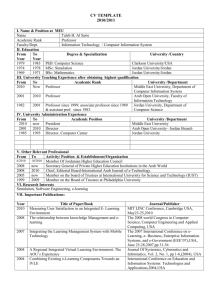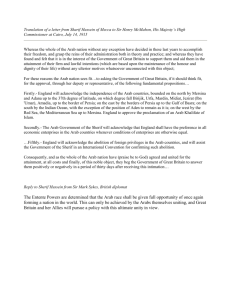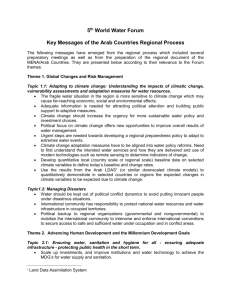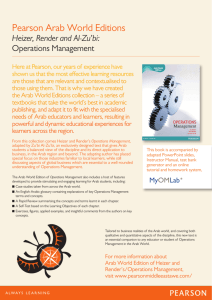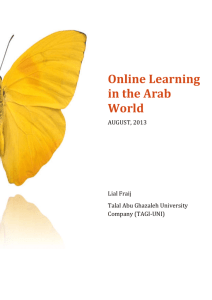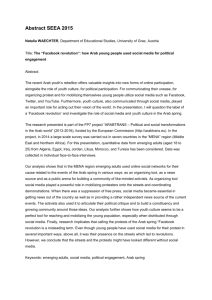PowerPoint Slides - Philadelphia University
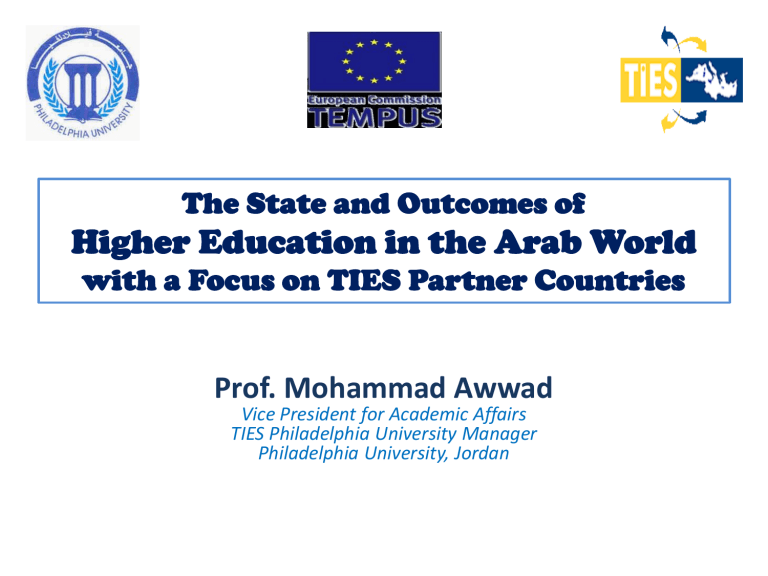
The State and Outcomes of
Higher Education in the Arab World
with a Focus on TIES Partner Countries
Prof. Mohammad Awwad
Vice President for Academic Affairs
TIES Philadelphia University Manager
Philadelphia University, Jordan
Outline:
1. General description of the higher education scene in the Arab
World as shown by performance indicators of Arab universities and research centers.
2. Roadmap for improving the quality of higher education provision as well as its economic feasibility is in making proper use of blended/hybrid education.
3. Survey and analysis of both e-learning and blended education.
4. Success stories and relevant data and examples.
Higher Education & Scientific Research:
HE in the Arab World:
Number of HE institutes increased from 10 in 1940 to 260 in 2007
(Now about 450).
Number of Students increased from 137000 in 1960 to about 7 million in 2007 (Now 8.1 million).
Only 2.4% attending HEIs compared with:
Country
USA
S. Korea
UK, Israel
France
Jordan
Lebanon
Saudi Arabia
Attendance %
5.6%
5%
3.6%
3.4%
3.0%
2.8%
1.4%
According to published statistics:
Only 2.4% attending HEIs.
To accommodate the growing number of students:
New Universities,
Increase capacity in universities, or
Using e-learning and blended education.
Arab Universities are still below the required level.!!!
Six indicators are used for assessing our universities:
1.
No. of Registered Patents.
2. University Ranking.
3. Published Scientific Papers.
4. Expenditure on Research & Development.
5. Arab participation in the European Programs.
6. World Intellectual Property Indicators
1. Patents & Arab World:
Patents & Arab World:
Patents & Arab World:
According to the World Intellectual Property
Organization’s (WIPO) annual report (2011):
Country No. of Patents
1 Saudi Arabia 147
2 UAE 39
3 Egypt 33
4 Morocco 17
5 Tunisia 8
6 Syria 5
7 Algeria, Kuwait 4 each
8 Jordan, Lebanon 1 each
According to the 2012 report of
USA PATO:
Country No. of Patents
Arab World
USA
1087
2.5 million
Japan
South Korea
Finland
849 467
97 956
17661
2. Ranking of Arab Universities:
There are no Arab Universities among the top 500 universities according to NTU
Ranking, 2012.
According to Shanghai Academic Ranking, 2012; only THREE KSA universities, and
ONE Egyptian university appear.
Shanghai Academic Ranking of some World Universities. (Shanghai, 2012).
3. Number of Scientific Published Papers:
Ranking of countries by number of scientific papers:
Ranking of Countries by No. of Scientific Papers:
Ranking of Countries by No. of Scientific Papers:
Arab international cooperation in scientific publishing. (AKR, 2009)
Ranking of Countries by No. of Scientific Papers: (1998-2007)
4. Expenditure on Research & Development:
Expenditure on Research & Development:
• The Arab World allocates less than 1% of the GDP for research and development .
• South Korea allocates 3.74%.
• The GDP for:
Jordan: 28 B$
Lebanon: 42 B$
Country
South Korea
Japan
USA
Germany
EU
(27 states)
China
Denmark
Egypt
Saudi Arabia
Tunisia
Spending on RD as % of GDP
3.74%
3.67%
2.7%
2.3%
1.84%
1.97%
2.4%
GDP
(USD)
1.12T
5.87T
15T
3.57T
13.38T
7.3T
332B
0.23%
(2007)
229.5B
0.05%
(2007)
576.8B
0.86%
(2007)
45.86B
5. Arab participation in the European Programs:
Source: AKR, 2009
6. World Intellectual Property Indicators:
(WIPO 2009)
On-line Learning:
In 2002, the number of students enrolled in at least one online course was 1620970. In 2010, the number reached 6142280.
31% of HE Students take at least one course online.
65% of HE Academic Leaders say that online learning is a critical part of their long-term strategy.
51% of HE Academic Officers consider elearning and face-toface outcomes the same.
Source: Allen & Seaman, 2011
On-line Learning:
Prof. Andrew Ng. taught in 2011 online course to a class of 100000 students. (Ref: Friedman, 2012).
Prof. Andrew Ng & Prof. Koller founded online environment
(COURSERA) for bringing high quality online courses free of charg.
High quality online courses are prepared by top universities in
USA.
Recently, MIT & Harvard University joined COURSERA through their joint venture (Edx). In March 2012, about 120000 students signed up for the 1st MIT course (Circuits & Electronics). (Ref:
DeSantis, 2012).
Prof. John Hennessy told his colleages «Tsunami is coming » …….
Harvard & MIT awarded their Edx first certificate 7000 students which is DOUBLE the number of degrees MIT awarded at this year
(2011). (Ref: Savage, 2012).
E-Learning & Arab Universities:
Arab universities can face critical challenges and problems;
The absence of any e-learning culture.
Urgent need for responsible academic leadership that understand and appreciate e-learning and blended education.
The need for an appropriate e-learning strategies that can over ride the challenges and accelerate the adaptation of e-learning in
Arab educational systems.
Present rules and regulations at Arab universities are not flexible to accommodate the application of e-learning.
With these challenges, e-learning and blended education can be considered as an important key to reduce these negative aspects and turn them in the proper directions.
Online Learning:
Online learning is an important engine for positive change in Higher Education especially that it provides lower-cost quality education. It requires, however, a technology friendly environment. Its major benefits and obstacles are as follows:
The State and Outcomes of
Higher Education in the Arab World
with a Focus on TIES Partner Countries
Prof. Mohammad Awwad mawwad@ philadelphia.edu.jo

